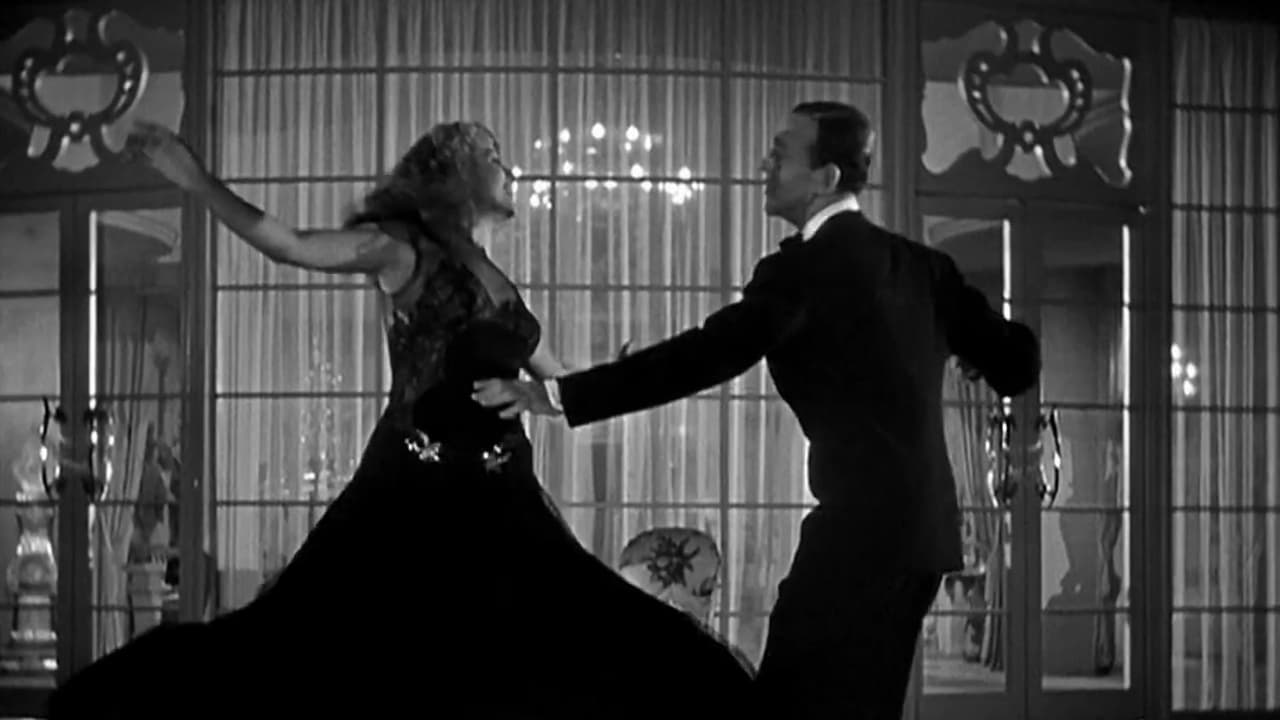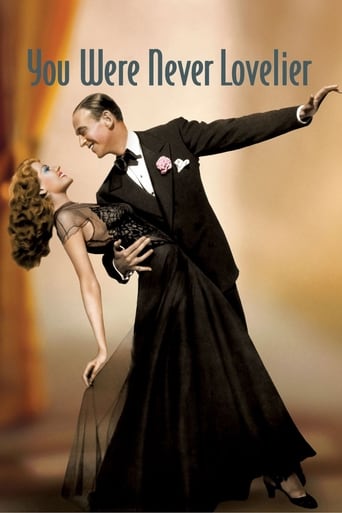moonspinner55
Fred Astaire is re-teamed with Rita Hayworth one year after their big hit for Columbia, "You'll Never Get Rich". That film put Hayworth on the Hollywood map, yet her performance in this wan romantic musical hardly gives a suggestion why she was suddenly so popular. Down Buenos Aires way, a tyrannical hotel owner demands that his four daughters marry in order of age; one may think the picture takes place in the 18th century...but no, it's 1942. Astaire, playing a former hoofer-turned-gambler who goes back to dancing to earn some money, gets mixed up impersonating a letter-writing admirer to Hayworth's society beauty. Fred, gazing at Rita with a brotherly smile, tries but fails to make the sparks fly, while she's so aloof and indifferent (lip-synching to her songs like a wind-up doll) that any signs of romance quickly sputter. They do dance comfortably together, however, and the Jerome Kern score, while not especially memorable, is pleasant enough. ** from ****
weezeralfalfa
Why was the supposed location of this delightful musical romantic comedy in Argentina, when minimal effort is made to convince the audience that it actually takes place there? This was the era of FDR's 'good neighbor policy', to try to keep Latin American countries(and especially Argentina)from siding with the Fascists in WWII. Film studios were pressured to include some films supposedly located in Latin countries, featuring some Latin musical performers. Fox had done or would do several prominent musicals toward this goal, including 'Down Argentine Way". Unfortunately, the latter backfired and was banned in Argentina, as the Argentine brass didn't like the phony attempt to characterize themselves. I guess the studio brass of this film learned that lesson and made little attempt to convince that they were actually in Argentina, aside from Cugat's orchestra, and Rita's partial Latin heritage. But, according to the script, Cugat's bunch are actually from NYC, along with Astaire's character!Yes, the screen play is pretty hokey and corny all around, but apparently the brass were hoping this would mostly add to the appeal. On the whole, it's quite fun. The complicated relationships that develop between the principals is quite entertaining. The frequent heated exchanges between the dictatorial Adolphe Menjou(el groucho) as the old fashioned father of a house full of debutant daughters, and Fred(jumping jack), as the broke vacationing hoofer Bob Davis, or Menjou's greeter, Fernando(court jester)(Gus Schilling), are priceless. Rita(refrigerator princess) or the other main characters are sometimes included. Menjou's role as 'Father knows best' is really the centerpiece of the screen play. We see why, given a good script, Menjou was such a good scene stealer. Perhaps you can't take his frequent shouting down at others, but this was an effective part of the comedy for me.Rita, at age 24, is pretty and vivacious, but sometimes acts almost mannequin-like, with a manufactured-looking big smile. Apparently, this was intended. In many other scenes, her acting is fine, as she alternatively discourages or encourages Fred's interest in her. Fred, at nearly twice her age and looking it, is actually playing someone more her supposed age(probably about 20). But his other striking attributes apparently more than compensated for this.Excusing the decision to film this in B&W, rather than color, on wartime financial limits doesn't ring true to me. This same year, Rita starred in the Fox Technicolor musical "My Gal Sal". The year before, she costarred in the Fox Technicolor "Blood and Sand". In '44, Columbia finally filmed Rita-starring "Cover Girl" in Technicolor. Lacking competition from TV in this era, I think most studios, including MGM, were depending on the quality of their stars, music and scripts, in most cases, to attract audiences. The Kerns and Mercer score is not very memorable. But then, dancing , rather then singing, was supposed to be the forte of this film. I thought the title song was weak. I'm surprised the film wasn't titled "Dearly Beloved". soloed by both Fred and Rita. It also fits in with the love letters sent by Menjou's character to daughter Maria(Rita).Cugat's orchestra included a sizable chorus, lead by cute, personable, Lina Romay, who got a few solo or duet segments. They are featured in 4 numbers. Lina was a NYC-bred Latino, who sometimes was included as an actress or singer in films. For a version of "Chui, Chui", featured in this film, where she solos the entire number, see You Tube. Leslie Brooks and Adele Mara, as Rita's slightly younger sisters, are OK and pretty, and get to sing one number together. They and Lina would live much longer and presumably happier lives than Rita, whose star shown much brighter for some years to come. Barbara Brown was also well cast as Menjou's wife and foil, infamous for her supposedly harmless derringer converted into a cigarette lighter.Fred gets to dance around Menjou's office, including on the furniture, during his unofficial audition for a spot in Menjou's nightclub. Later, Fred and Rita do a light romantic dance sequence on the family patio to the memorable "I'm Old Fashioned". Then, they dance more vigorously to "The Shorty George", which incorporates elements of jive and tap dancing. The finale begins with a Cugat band serenade outside Rita's window, followed by Fred's arrival as a knight-in-shining-armor on horse, in supposed mimicry of Rita's one time heartthrob: Luckinbaugh. This is followed by another Fred + Rita romantic dance, to the title song, and ends with their first kiss.After leaving RKO and Ginger, Fred was paired on film with quite a few leading ladies: some famous dancers, others not. It's not real surprising that he apparently found Rita his favorite dance partner, nor that she considered this her favorite film. This was also the year that Fred costarred with Bing in that classic musical extravaganza "Holiday Inn", which unfortunately overshadowed this film, although, again, unforgivably shot in B&W.
Trixie is for Kids
After watching the Fred and Ginger series numerous times, I was sure that I would never find a pairing that could equal them.Well, I was wrong - VERY wrong.What I longed for after watching this movie were move Rita and Fred movies, and unfortunately there is only one other that isn't quite as good.Naturally the storyline is thin and predictable, but that's not what we watch musicals for - especially not those with Fred Astaire. And Rita's dancing ability compliments his, even without her grabbing her dress.The only thing that I found irritating and superfluous was the part played by Xavier Cugat. It seems like the studio spent a lot of money on a name where a good studio orchestra would have sufficed.Anyway, the movie is warm and wonderful, and Fred's charm in the ending scenes is enough to make your heart melt, along with the great Fred/Rita kiss at the end.I'm glad he finally threw away his inhibitions and was able to get past those ridiculous, frozen-armed monster hugs he'd do with Ginger, and ended this movie in the adult way intended.This is a film definitely worth seeing and enjoying more than once.

